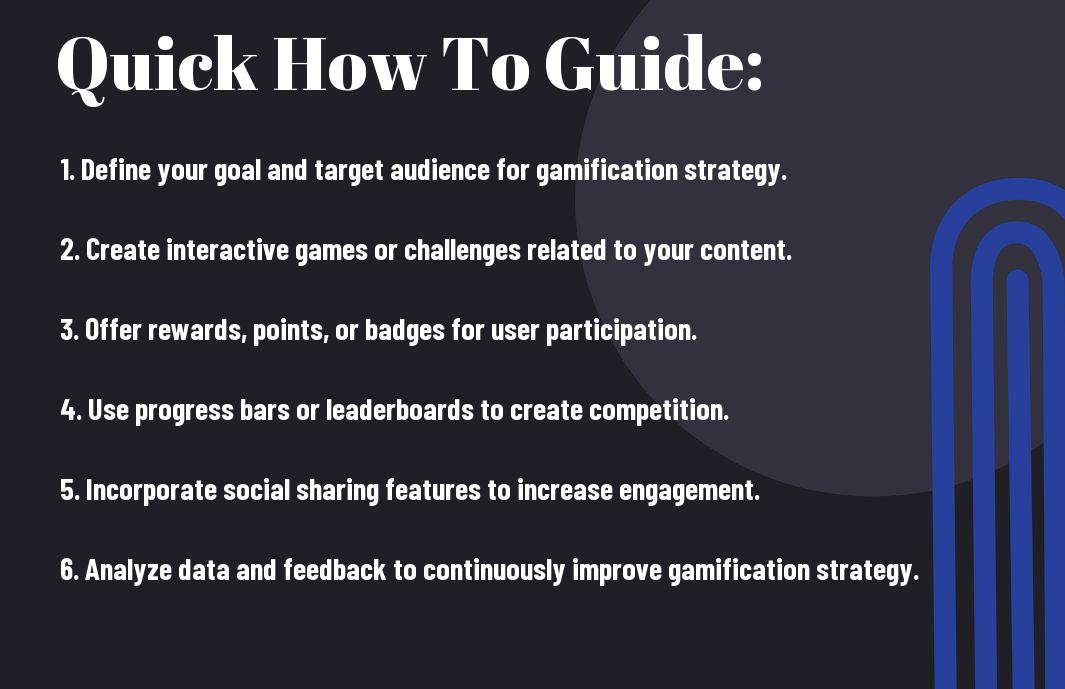Just imagine turning user engagement on your website into a fun and addictive experience! By incorporating gamification elements, you can keep visitors hooked and coming back for more. In this guide, you will learn how to leverage game mechanics like points, badges, and leaderboards to increase user interaction, drive loyalty, and enhance overall user experience. Ready to level up your website engagement? Let’s get started!

Key Takeaways:
- Understand your target audience: Before implementing gamification on your website, it’s crucial to have a good understanding of your target audience’s preferences, interests, and behavior.
- Implement various game mechanics: Incorporate different game mechanics such as points, levels, badges, and leaderboards to make the user experience more engaging and interactive.
- Reward and incentivize engagement: Offer rewards, incentives, or discounts to users who actively engage with the gamified elements on your website to encourage continued participation and loyalty.
Understanding Gamification
What is Gamification?
While you may have heard the term “gamification” before, you may not fully understand what it means. Essentially, gamification involves applying game-design elements and principles in non-game contexts to engage users and drive desired behaviors.
The Science Behind Gamification
If you want to effectively use gamification on your website, it’s important to understand the science behind it. Gamification works because it taps into fundamental human desires such as competition, achievement, and rewards. By incorporating elements like points, badges, leaderboards, and challenges, you can create a more interactive and engaging experience for your users.
One key aspect of the science behind gamification is the concept of intrinsic and extrinsic motivation. Intrinsic motivation comes from within, where you are driven by internal rewards like enjoyment or personal satisfaction. Extrinsic motivation, on the other hand, comes from external rewards like points or prizes. Gamification leverages both types of motivation to keep users engaged and motivated to interact with your website.

Setting Goals for Gamification
Identifying Target Audience
One of the first steps in setting goals for gamification is identifying your target audience. Understanding who your users are will help you tailor the gamification elements to their preferences and interests. Consider factors such as age, gender, interests, and behaviors when defining your target audience for gamification.
Defining Engagement Metrics
The engagement metrics are important in measuring the success of your gamification strategy. Clearly defining these metrics will help you track how users interact with the gamified elements on your website. You can use metrics such as time spent on the website, frequency of visits, completion of challenges, or social sharing to measure engagement.
It’s important to note that not all engagement metrics will be relevant to your specific goals. You should choose metrics that align with the objectives you want to achieve through gamification on your website. For example, if your goal is to increase user retention, metrics like return visits and session duration can be more valuable.
Setting Realistic Goals
Little by little, it’s crucial to set realistic goals for your gamification efforts. By establishing achievable milestones, you can track progress and make adjustments to your strategy as needed. Consider starting with small objectives that can lead to larger goals over time.
Metrics such as user engagement, conversion rates, and customer satisfaction can give you valuable insights into the effectiveness of your gamification strategy. By analyzing these metrics regularly, you can continuously optimize your gamification elements to improve user engagement on your website.
Designing Gamification Elements
Now, if you want to learn more about Using gamification to increase website engagement, designing the right gamification elements is crucial to capturing and maintaining the interest of your users. Here’s how you can effectively implement gamification on your website.
Types of Rewards and Incentives
For rewards and incentives, there are various options you can consider incorporating into your gamification strategy. These can range from points and badges to leaderboards and virtual currency. Levels and unlockable content are also popular choices. By having a mix of these incentives, you can appeal to different types of users and keep them engaged on your website.
Assume that by offering a variety of rewards and incentives, you can encourage users to explore different areas of your website and spend more time engaging with your content.
| Types of Rewards and Incentives | Description |
|---|---|
| Points | Can be accumulated and redeemed for benefits |
| Badges | Achievements displayed on a user’s profile |
| Leaderboards | Ranking system to stimulate competition |
| Virtual Currency | Used for virtual transactions within the platform |
| Levels | Progression milestones that unlock new features |
Creating Engaging Challenges and Quests
For challenges and quests, you can design tasks that users need to complete to earn rewards or advance to the next level. Engaging challenges should be relevant to your website content and offer a good balance of difficulty to keep users interested.
Assume that by creating a sense of accomplishment and progression through challenges and quests, you can motivate users to continue interacting with your website.
Using Visual Cues and Feedback
Creating visual cues and feedback is important to guide users through the gamification process. Visual cues can include progress bars, notifications, and animations to keep users informed about their achievements and current status. Feedback, such as immediate responses to user actions, help reinforce positive behaviors and enhance the overall gamified experience.
Challenges and quests that provide clear visual cues and feedback can make the gamification elements more intuitive and engaging for your users.
Implementing Gamification on Your Website
Choosing the Right Gamification Platform
To effectively implement gamification on your website, you need to choose the right gamification platform. Any platform you select should offer a wide range of features that align with your specific goals and target audience. Look for platforms that provide customizable gamification elements such as badges, leaderboards, points, and rewards to keep your users engaged.
Integrating Gamification with Existing Features
To seamlessly integrate gamification with your existing website features, you must carefully plan the implementation process. If your website already has user profiles, forums, or e-commerce capabilities, consider how gamification can enhance these areas. Whether it’s incentivizing users to complete tasks or participate in discussions, gamification should complement and enrich your current offerings.
Plus, remember that too much gamification can overwhelm your users. Seek a balance between gamified elements and the core functionality of your website to ensure a seamless user experience.
Testing and Iterating Gamification Elements
Before fully rolling out gamification on your website, it’s crucial to test different elements to see what resonates most with your users. Experiment with various game mechanics, rewards systems, and feedback loops to determine what drives engagement. Elements that yield positive results can be iterated upon and optimized for better performance.
Platform, gather feedback from your users to understand what they enjoy and what can be improved. Regularly monitor analytics to track user interactions with gamified elements and make data-driven decisions to enhance your gamification strategy.
Factors Affecting Gamification Success
Unlike traditional methods, gamification relies on various factors to be successful in boosting user engagement on your website. Understanding these factors is crucial for effective implementation of gamification strategies.
User Experience and Usability
Affecting user experience and usability, the design and functionality of the gamified elements on your website play a significant role in engaging your audience. Clear navigation, intuitive user interface, and seamless integration of game mechanics are imperative for a positive user experience. By optimizing these aspects, you can ensure that users easily interact with the gamified elements on your website, leading to increased engagement.
Social Sharing and Collaboration
Even social sharing and collaboration features can impact the success of gamification on your website. By incorporating elements that allow users to share their achievements and collaborate with others, you can create a sense of community and encourage users to stay engaged. Leaderboards, challenges, and rewards for social interactions can facilitate a sense of competition and camaraderie among users, driving higher levels of engagement.
Plus, social sharing not only increases user engagement but also extends the reach of your gamified content to a wider audience. When users share their accomplishments on social media platforms, they are imperatively promoting your website and encouraging others to participate, further enhancing user engagement.
Personalization and Adaptation
Affecting personalization and adaptation, tailoring the gamified experiences to each user’s preferences and behaviors can significantly impact engagement levels. By gathering data on user interactions and behavior, you can customize challenges, rewards, and feedback to match individual preferences, keeping users motivated and invested in the gamified elements on your website.
Factors such as personalized recommendations, adaptive difficulty levels, and individualized progress tracking can enhance the overall user experience and drive long-term engagement on your website. Knowing how to effectively implement these personalization strategies can make a difference in the success of your gamification efforts.
Tips for Effective Gamification
Keeping it Simple and Fun
For effective gamification, it’s crucial to keep things simple and fun for your users. Complicated game mechanics or confusing rules can overwhelm and frustrate your users, leading to disengagement. Focus on creating easy-to-understand challenges and rewards that are enjoyable to participate in. Engagement is more likely when the experience is intuitive and entertaining. Thou, by keeping it simple and fun, you can increase user participation and loyalty.
Providing Clear Instructions and Feedback
On the other hand, clear instructions and feedback are necessary for effective gamification. Without guidance, users may not understand what is expected of them or how to progress in the game. Regular and constructive feedback can motivate users to continue engaging with your website. Gamification features such as progress bars, badges, and leaderboards can help users track their achievements and stay focused on their goals. It’s important to keep instructions clear and easily accessible, and to provide timely feedback to encourage ongoing participation.
Encouraging Social Sharing and Competition
There’s no denying the power of social sharing and competition in boosting user engagement through gamification. When users can share their achievements or compete with friends, it adds a social element to the experience. This not only makes the activity more enjoyable but also motivates users to stay engaged and strive for improvement. Additionally, competition can fuel a sense of urgency and excitement among users, driving them to actively participate and excel in the game. Simple features such as leaderboards or challenges that encourage friendly competition can go a long way in increasing user engagement and retention.
Summing up
On the whole, integrating gamification into your website can significantly boost user engagement and enhance your overall user experience. By leveraging game design elements like points, badges, leaderboards, and rewards, you can motivate users to engage more frequently and deeply with your platform. Additionally, gamification can make mundane tasks more enjoyable and increase user retention by fostering a sense of accomplishment and progress. Remember to continuously assess and tweak your gamification strategies based on user feedback and data analytics to ensure their effectiveness and relevance to your audience.